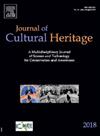In situ long-term monitoring of microbial patinas on the external marble of Florence Cathedral after treatments with essential oils
IF 3.3
2区 综合性期刊
0 ARCHAEOLOGY
引用次数: 0
Abstract
The control of biological patinas on cultural heritage stones is a challenging task as treatments are often not long-lasting, and the microorganisms naturally tend to colonize any surface that meets their living requirements. Historically, the most widely used strategy to combat the biodeterioration of stone cultural heritage has involved the application of synthetic and aggressive biocides. However, recent developments have shifted towards more sustainable conservation methods, including the use of natural biocides. Among these, essential oils (EOs) have gained attention due to their well-documented antimicrobial properties. In previous work, we treated selected areas of the external marble of Florence Cathedral, which were affected by extended darkening, with thyme and oregano EOs. The efficacy of these treatments was assessed in the short- and mid-term using a multidisciplinary approach. In this work, we report the long-term evaluation (after four years) of these treatments, employing on-site microscopy, non-invasive colorimetric, and ATP (adenosine triphosphate) assays. This study shows that treatments performed with different solutions have varying efficacy over time, and that the solutions containing both thyme and oregano essential oils (OT) are those showing the best long-term effectiveness on microbial activity. This extended monitoring period is crucial for understanding the durability of the treatments and their effectiveness in controlling biodeterioration over time.

佛罗伦萨大教堂外部大理石经精油处理后的微生物铜绿的现场长期监测
控制文化遗产石上的生物铜绿是一项具有挑战性的任务,因为处理通常不持久,微生物自然倾向于在任何满足其生活需求的表面上定居。从历史上看,最广泛使用的对抗石质文化遗产生物退化的策略包括使用合成和强效杀菌剂。然而,最近的发展已经转向更可持续的保护方法,包括使用天然杀菌剂。其中,精油(EOs)因其充分记录的抗菌特性而受到关注。在之前的工作中,我们用百里香和牛至叶精油处理了佛罗伦萨大教堂外部大理石的选定区域,这些区域受到长时间变暗的影响。采用多学科方法评估这些治疗的短期和中期疗效。在这项工作中,我们报告了这些治疗的长期评估(四年后),采用现场显微镜,非侵入性比色法和ATP(三磷酸腺苷)测定。这项研究表明,随着时间的推移,用不同的溶液进行的治疗效果不同,含有百里香和牛至精油(OT)的溶液对微生物活性的长期效果最好。这种延长的监测期对于了解处理的持久性及其在控制长期生物恶化方面的有效性至关重要。
本文章由计算机程序翻译,如有差异,请以英文原文为准。
求助全文
约1分钟内获得全文
求助全文
来源期刊

Journal of Cultural Heritage
综合性期刊-材料科学:综合
CiteScore
6.80
自引率
9.70%
发文量
166
审稿时长
52 days
期刊介绍:
The Journal of Cultural Heritage publishes original papers which comprise previously unpublished data and present innovative methods concerning all aspects of science and technology of cultural heritage as well as interpretation and theoretical issues related to preservation.
 求助内容:
求助内容: 应助结果提醒方式:
应助结果提醒方式:


